Design and Implementation of Polar UAV and Ice-Based Buoy Cross-Domain Observation System
Abstract
1. Introduction
2. System Design and Implementation
2.1. Overall System Design
2.2. Ice-Based Buoy System
2.3. Quadcopter UAV System
3. Cooperative Mode of UBCOS
3.1. Hierarchical Structure
3.2. Cooperative Navigation Mode
3.3. Contact Charging System
3.4. Autonomous Operation Process
4. Arctic Field Validation
5. Conclusions
Author Contributions
Funding
Data Availability Statement
Conflicts of Interest
References
- Cai, Q.; Wang, J.; Beletsky, D.; Overland, J.; Ikeda, M.; Wan, L. Accelerated decline of summer Arctic sea ice during 1850–2017 and the amplified Arctic warming during the recent decades. Environ. Res. Lett. 2021, 16, 034015. [Google Scholar] [CrossRef]
- Casey, J.A.; Howell, S.E.; Tivy, A.; Haas, C. Separability of sea ice types from wide swath C-and L-band synthetic aperture radar imagery acquired during the melt season. Remote Sens. Environ. 2016, 174, 314–328. [Google Scholar] [CrossRef]
- Dai, A.; Deng, J. Recent Eurasian winter cooling partly caused by internal multidecadal variability amplified by Arctic sea ice-air interactions. Clim. Dyn. 2022, 58, 3261–3277. [Google Scholar] [CrossRef]
- Wu, B.; Li, Z. Possible impacts of anomalous Arctic sea ice melting on summer atmosphere. Int. J. Climatol. 2022, 42, 1818–1827. [Google Scholar] [CrossRef]
- Li, X.M.; Sun, Y.; Zhang, Q. Extraction of sea ice cover by Sentinel-1 SAR based on support vector machine with unsupervised generation of training data. IEEE Trans. Geosci. Remote Sens. 2020, 59, 3040–3053. [Google Scholar] [CrossRef]
- Chen, J.; Kang, S.; Du, W.; Guo, J.; Xu, M.; Zhang, Y.; Chen, J. Perspectives on future sea ice and navigability in the Arctic. Cryosphere 2021, 15, 5473–5482. [Google Scholar] [CrossRef]
- Chen, J.; Kang, S.; You, Q.; Zhang, Y.; Du, W. Projected changes in sea ice and the navigability of the Arctic Passages under global warming of 2 °C and 3 °C. Anthropocene 2022, 40, 100349. [Google Scholar] [CrossRef]
- Lubin, D.; Massom, R. Polar Remote Sensing: Volume I: Atmosphere and Oceans; Springer: Berlin/Heidelberg, Germany, 2006. [Google Scholar]
- Shokr, M.; Sinha, N.K. Sea Ice: Physics and Remote Sensing; John Wiley & Sons: Hoboken, NJ, USA, 2023. [Google Scholar]
- Shokr, M.E.; Wilson, L.J.; Surdu-Miller, D.L. Effect of radar parameters on sea ice tonal and textural signatures using multi-frequency polarimetric SAR data. Oceanogr. Lit. Rev. 1996, 6, 634. [Google Scholar] [CrossRef]
- Beckers, J.F.; Renner, A.H.; Spreen, G.; Gerland, S.; Haas, C. Sea-ice surface roughness estimates from airborne laser scanner and laser altimeter observations in Fram Strait and north of Svalbard. Ann. Glaciol. 2015, 56, 235–244. [Google Scholar] [CrossRef]
- Gaffey, C.; Bhardwaj, A. Applications of unmanned aerial vehicles in cryosphere: Latest advances and prospects. Remote Sens. 2020, 12, 948. [Google Scholar] [CrossRef]
- Leira, F.S.; Johansen, T.A.; Fossen, T.I. A UAV ice tracking framework for autonomous sea ice management. In Proceedings of the 2017 International Conference on Unmanned Aircraft Systems (ICUAS), Miami, FL, USA, 13–16 June 2017; pp. 581–590. [Google Scholar]
- Wigmore, O.; Mark, B. Monitoring tropical debris-covered glacier dynamics from high-resolution unmanned aerial vehicle photogrammetry, Cordillera Blanca, Peru. Cryosphere 2017, 11, 2463–2480. [Google Scholar] [CrossRef]
- Eltoft, T.; Doulgeris, A.P.; Brekke, C.; Solbø, S.; Gerland, S.; Hanssen, A. Imaging sea ice structure by remote sensing sensors. In Proceedings of the 23rd International Conference on Port and Ocean Engineering under Arctic Conditions, Trondheim, Norway, 14–18 June 2015. [Google Scholar]
- Bhardwaj, A.; Sam, L.; Martín-Torres, F.J.; Kumar, R. UAVs as remote sensing platform in glaciology: Present applications and future prospects. Remote Sens. Environ. 2016, 175, 196–204. [Google Scholar] [CrossRef]
- Huang, X.; Liu, T.; Liu, H.; Wang, H. Overview of the application of unmanned aerial vehicles in the Arctic atmospheric observation system. In Proceedings of the 2022 WRC Symposium on Advanced Robotics and Automation (WRC SARA), Beijing, China, 20 August 2022; pp. 25–32. [Google Scholar]
- Ariya, P.A.; Jobson, B.T.; Sander, R.; Niki, H.; Harris, G.W.; Hopper, J.F.; Anlauf, K.G. Measurements of C2-C7 hydrocarbons during the Polar Sunrise Experiment 1994: Further evidence for halogen chemistry in the troposphere. J. Geophys. Res. Atmos. 1998, 103, 13169–13180. [Google Scholar] [CrossRef]
- Pixhawk. Pixhawk 4 Flight Controller. PX4 Autopilot. Available online: https://docs.px4.io/main/en/flight_controller/pixhawk4.html (accessed on 17 August 2025).
- Khudonogova, L.I.; Muravyov, S.V. Interval data fusion with preference aggregation for balancing measurement accuracy and energy consumption in WSN. Wirel. Pers. Commun. 2021, 118, 2399–2421. [Google Scholar] [CrossRef]
- Holybro. H-RTK F9P User Manual. Available online: https://holybro.com/ (accessed on 17 August 2025).
- SKYRC. S100neo User Manual. Available online: https://www.skyrc.com/s100neo?search=s100neo (accessed on 17 August 2025).
- Muravyov, S.V.; Nguyen, D.C. Method of interval fusion with preference aggregation in brightness thresholds selection for automatic weld surface defects recognition. Measurement 2024, 236, 114969. [Google Scholar] [CrossRef]

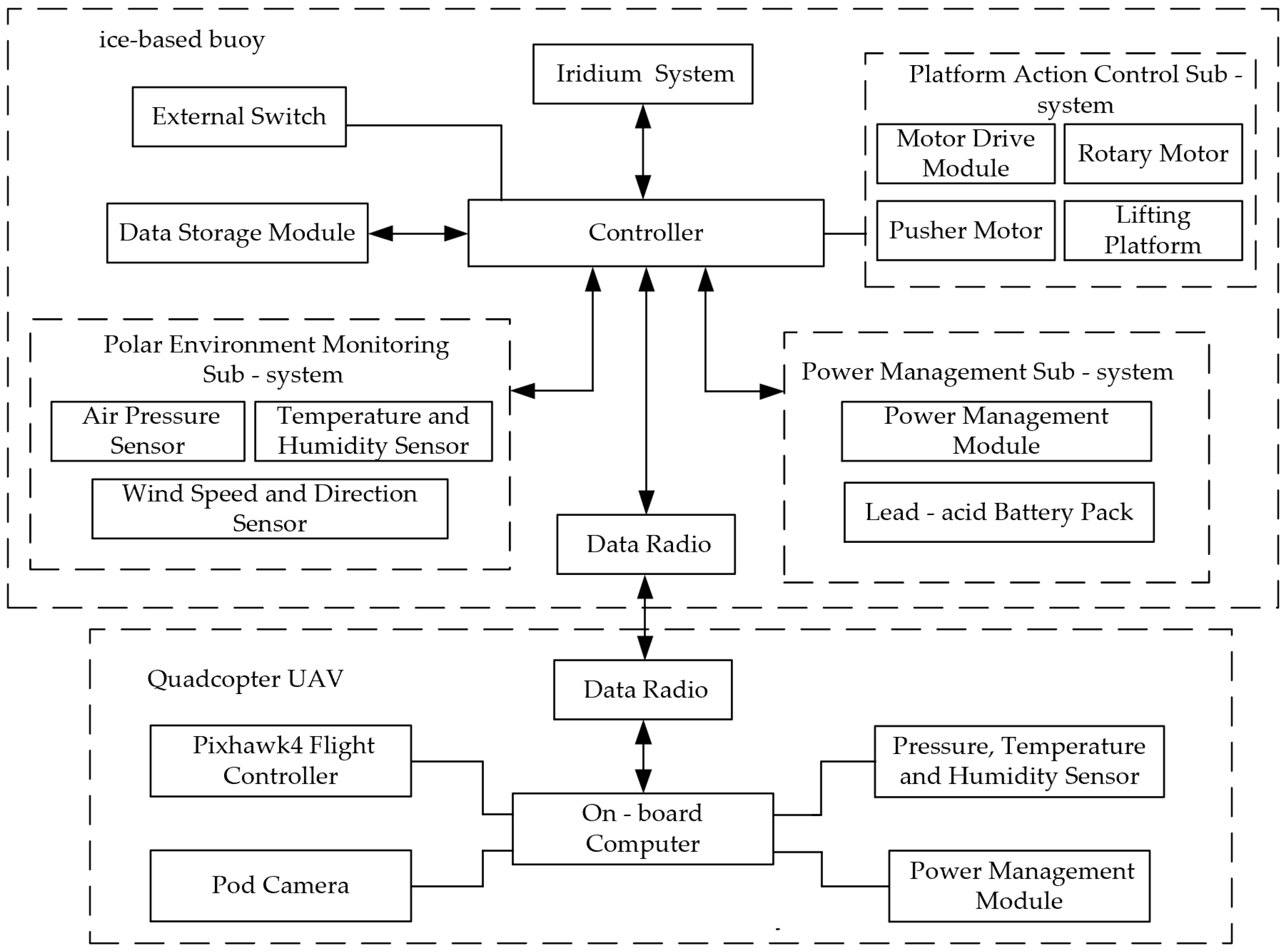

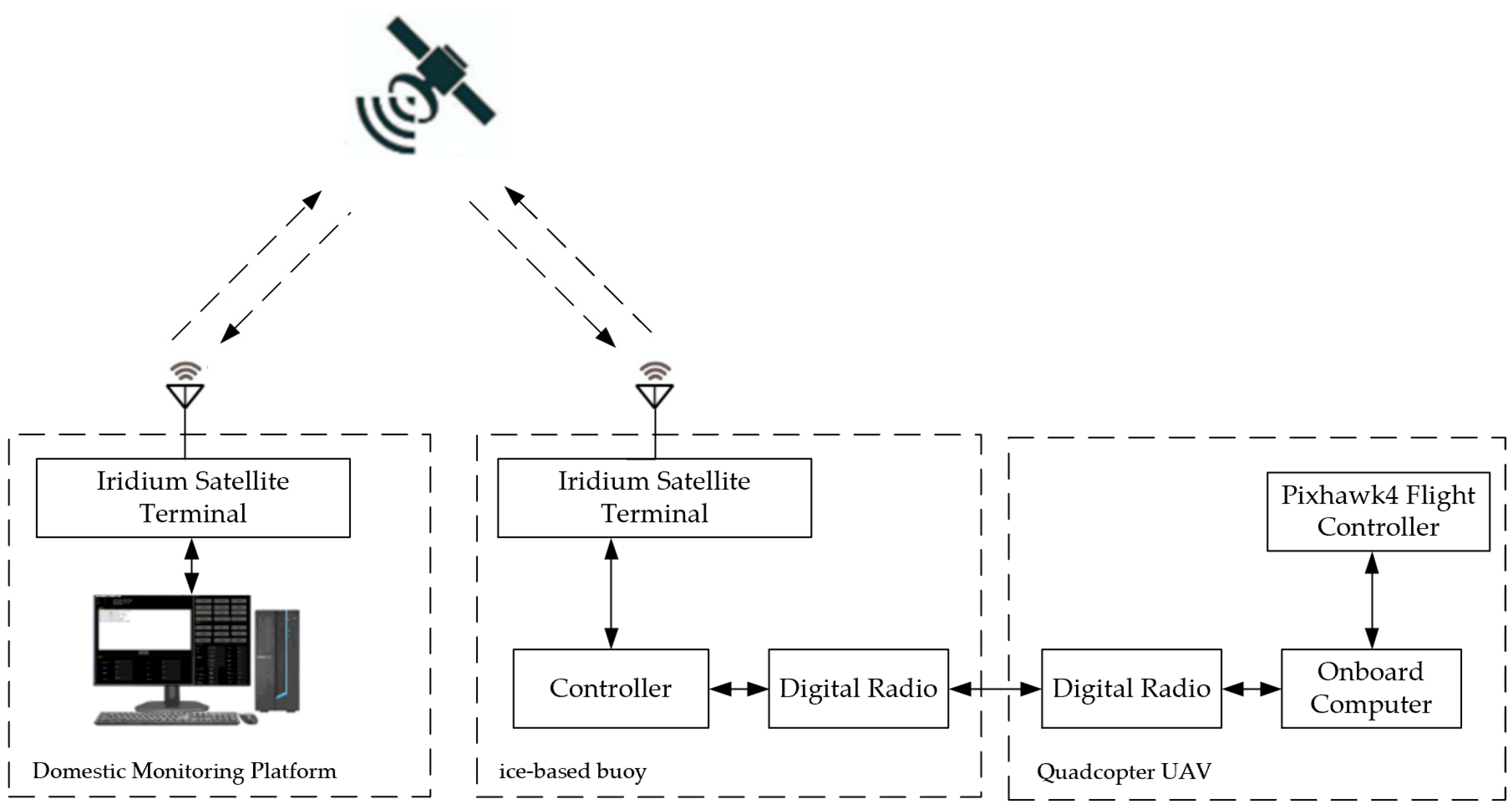

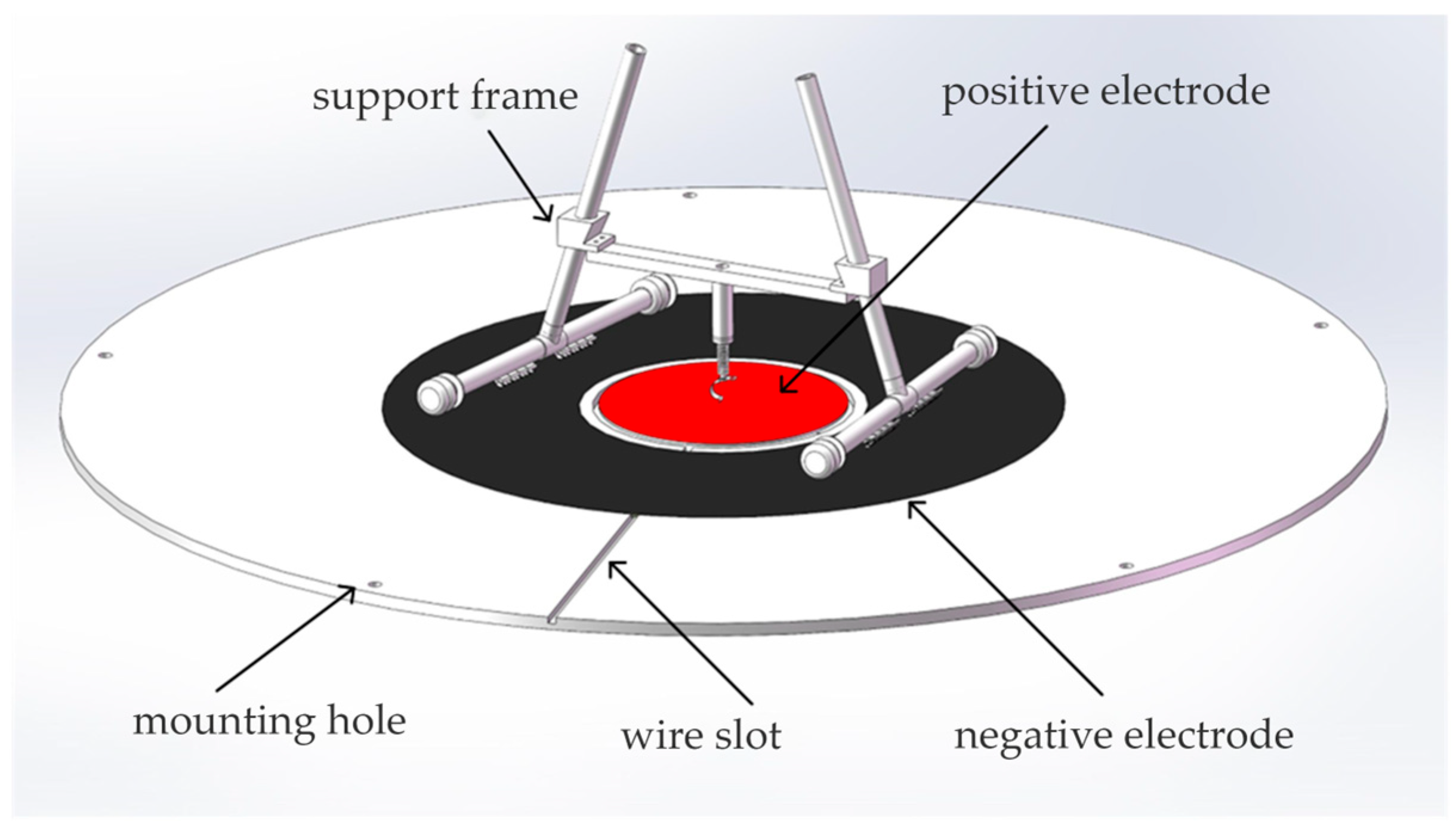
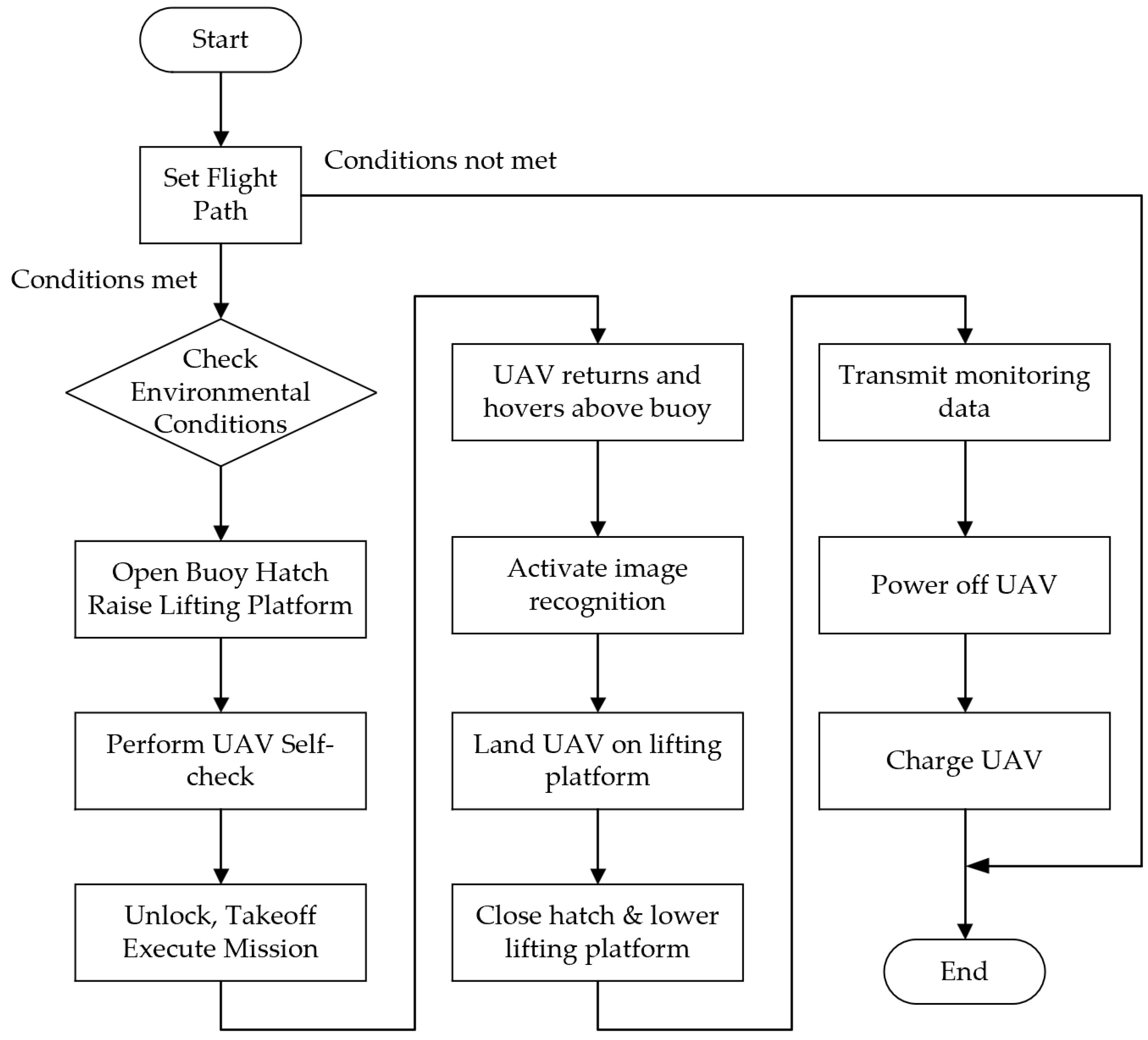
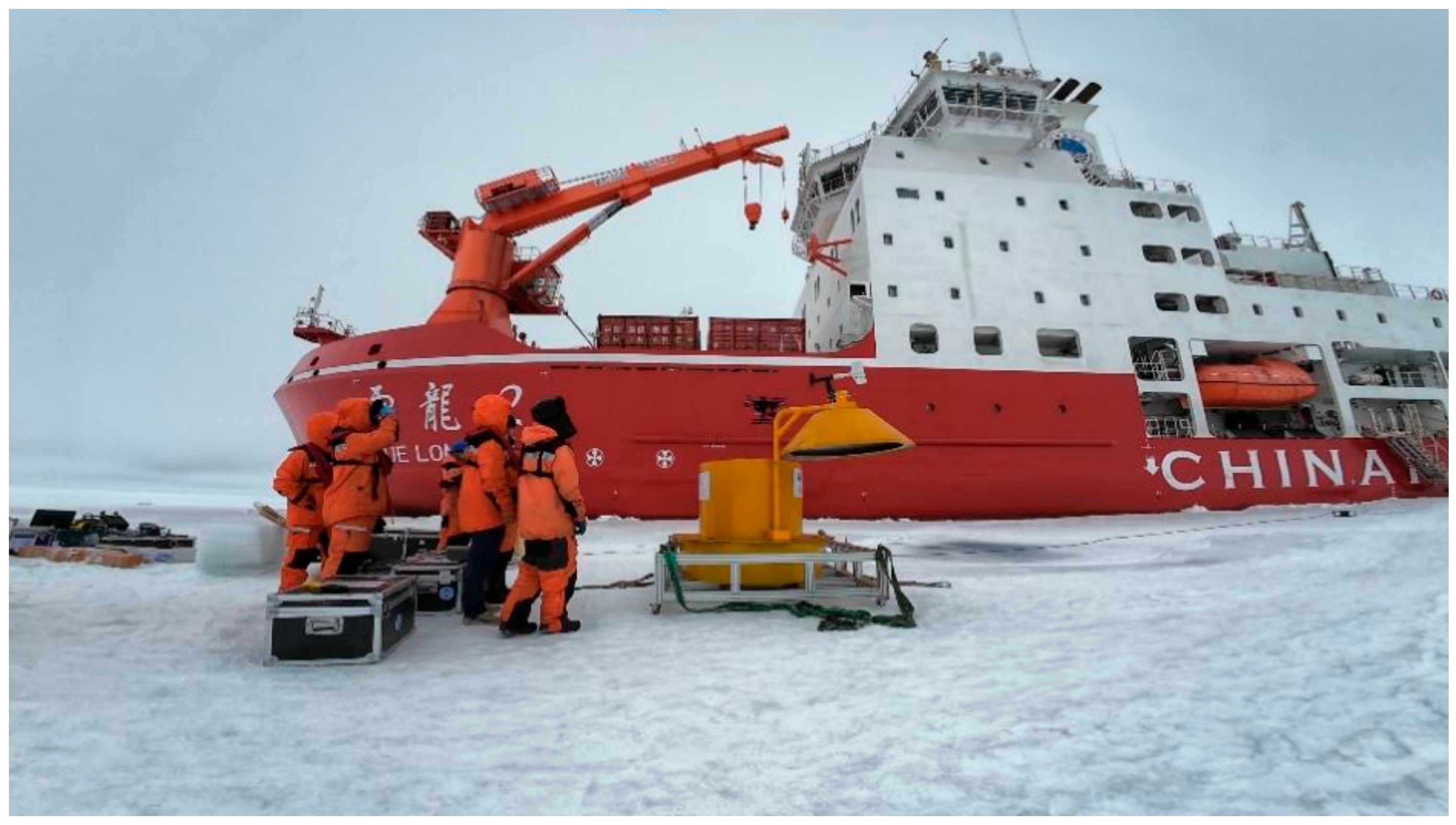
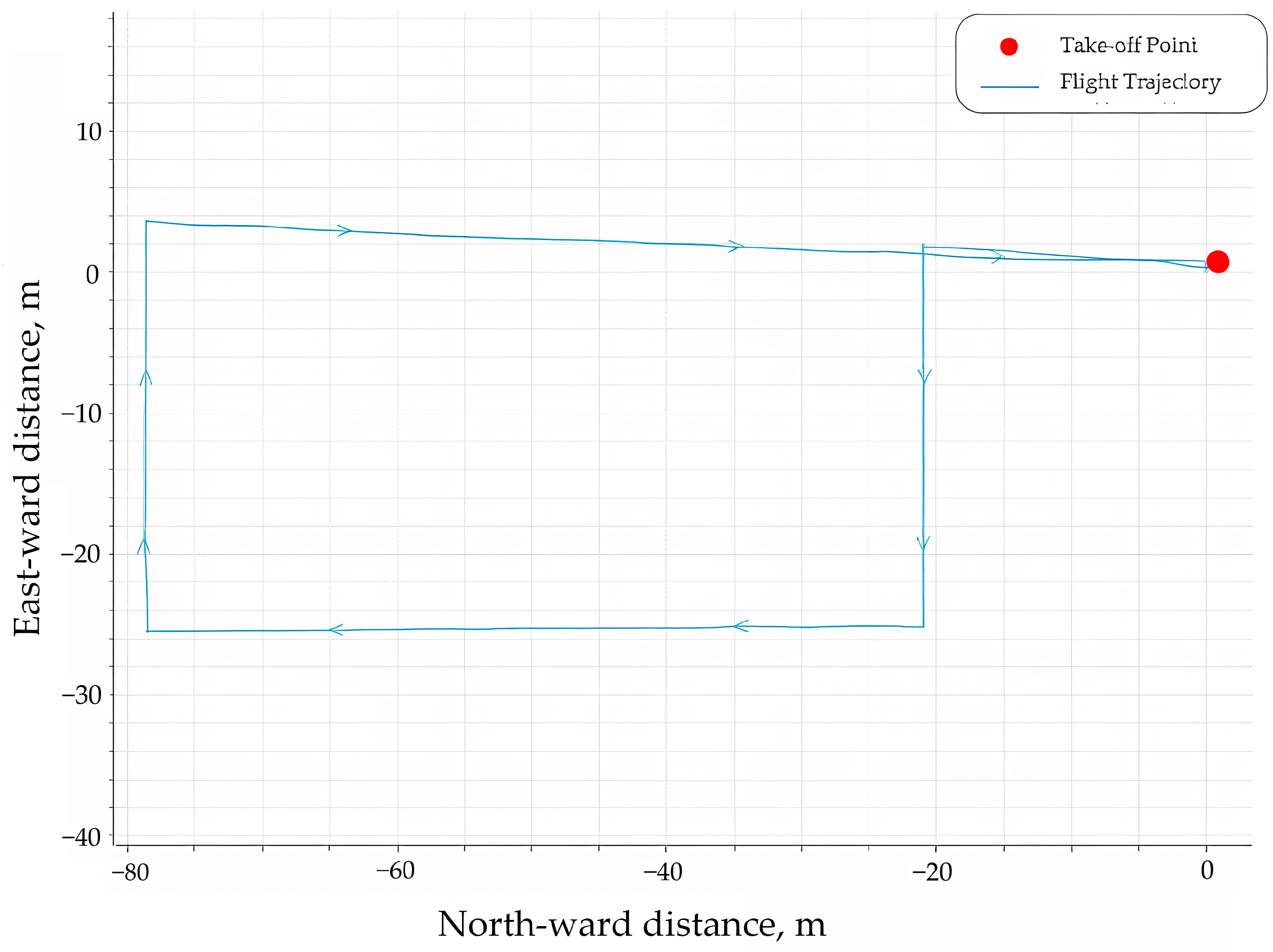
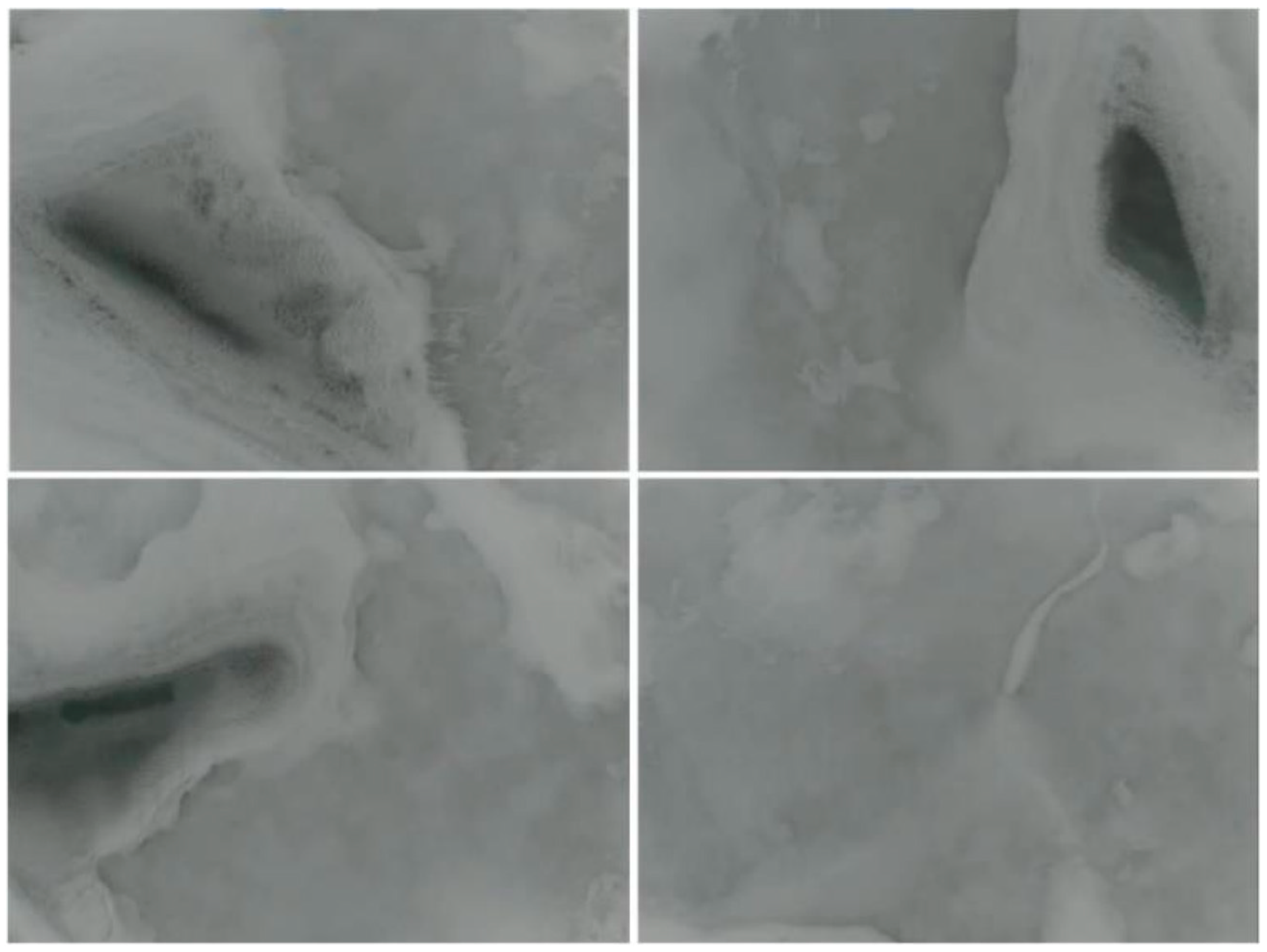
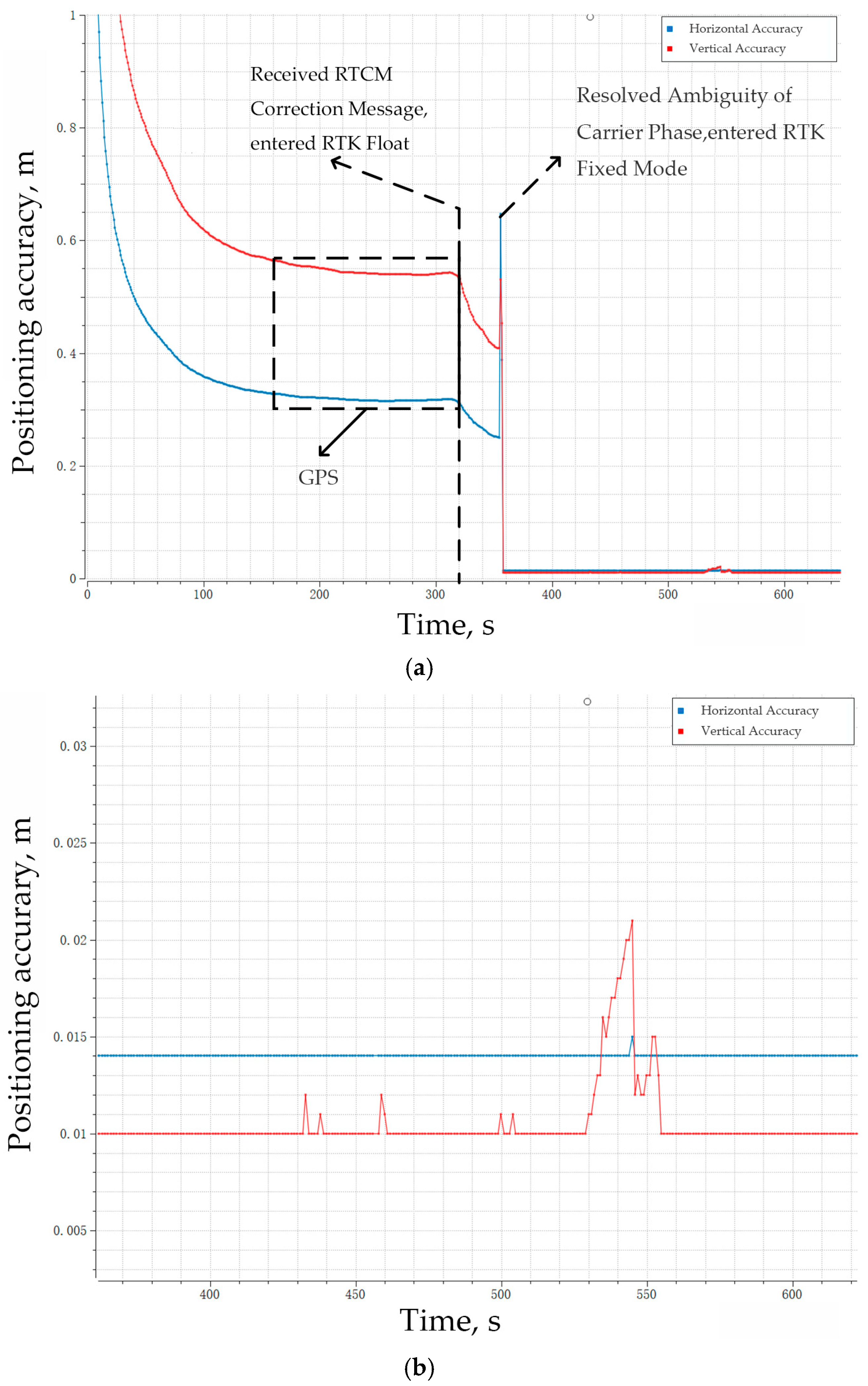
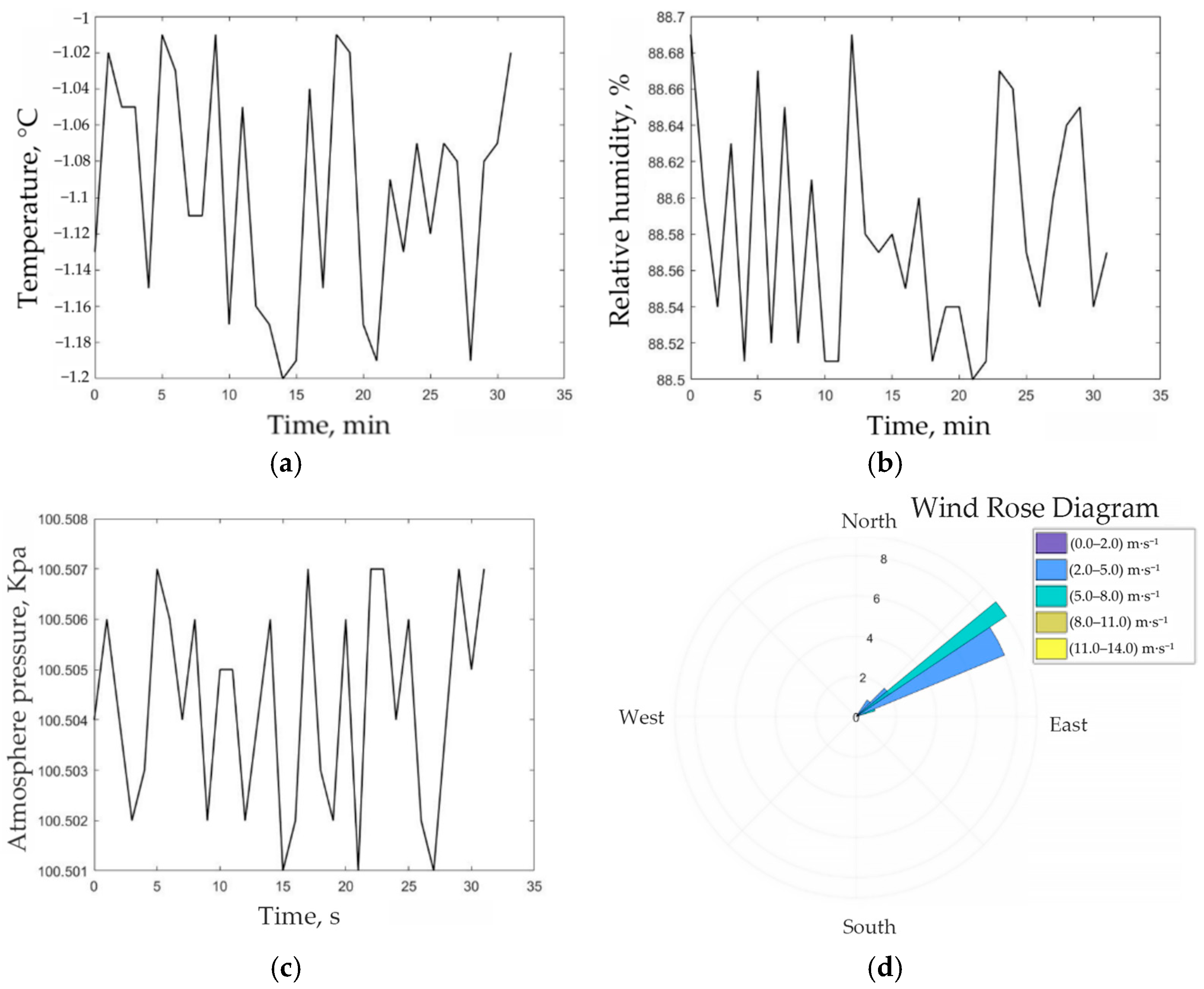

| Component | Height (mm) | Dimension (mm) | Material | Mass (kg) |
|---|---|---|---|---|
| Baseplate | 400 | 1500 | CP-Ti alloy | 59.080 |
| Connection panel | 3 | 1900 | 6061 Al alloy | 22.096 |
| Cabin | 800 | 1200 | 6061 Al alloy | 26.155 |
| Lifting platform | 165–1105 | 300 × 400 | Alumina | 13.900 |
| Hatch | 200 | 1205 | 6061 Al alloy | 14.112 |
| Rotating arm | 1050 | 60 | 6061 Al alloy | 13.082 |
| Device | Model/Specification |
|---|---|
| Controller | STM32F103ZET6 (STMicroelectronics, Geneva, Switzerland) |
| Barometric Sensor | Vaisala PTB210 (Vaisala, Vantaa, Finland) |
| Thermo-Hygrometer | Vaisala HMP 155 (Vaisala, Vantaa, Finland) |
| Anemometer | XFY3-1 (Micoyi (Beijing) Technology Co., Ltd., Beijing, China) |
| Rotary Motor | D57M31 (Leadshine Intelligent Control Co., Ltd., Shenzhen, China) |
| Linear Actuator | 150 mm/s-1000 N (100 kg) (Leadshine Intelligent Control Co., Ltd., Shenzhen, China) |
| RTK Reference Receiver | Holybro H-RTK F9P Base (Holybro Technology Co., Ltd., Shenzhen, China) |
| Iridium Satellite System | Iridium 9523 (Iridium Communications Inc., McLean, VA, USA) |
| Digital Radio | Holybro SiK Telemetry Radio V3 (Holybro Technology Co., Ltd., Shenzhen, China) |
| Data Storage Module | Openlog 64G (SparkFun Electronics, Niwot, CO, USA) |
| Lead-Acid Battery Pack | 2 × 12 V 250 Ah (Santak Electronics (Shenzhen) Co., Ltd., Shenzhen, China) |
| Parameter | Value |
|---|---|
| Mass | 3.2 kg |
| Diagonal wheelbase | 600 mm |
| Max takeoff weight | 4.0 kg |
| Payload capacity | 0.8 kg |
| Endurance | 36 min |
| Wind resistance | Level 6–7 |
| Power source | High-voltage Li-ion battery |
| Operating voltage | 23.1 V |
| Max flight altitude | 100 m |
| Device | Model |
|---|---|
| Flight controller | Pixhawk 4(Holybro Technology Co., Ltd., Wan Chai, Hong Kong SAR, China) |
| Onboard computer | NVIDIA Jetson Orin NX (NVIDIA Corporation, Santa Clara, CA, USA) |
| Gimbal-mounted camera | Pinling Q10F (Guangdong Pinling Technology Co., Ltd., Foshan, China) |
| RTK rover receiver | Holybro H-RTK F9P Helica (Holybro Technology Co., Ltd., Shenzhen, China) |
| Digital radio | Holybro SiK Telemetry Radio V3 (Holybro Technology Co., Ltd., Shenzhen, China) |
| Baro-thermo-hygrometer | BOSCH BME280 (Bosch Sensortec GmbH, Reutlingen, Baden-Württemberg, Germany) |
Disclaimer/Publisher’s Note: The statements, opinions and data contained in all publications are solely those of the individual author(s) and contributor(s) and not of MDPI and/or the editor(s). MDPI and/or the editor(s) disclaim responsibility for any injury to people or property resulting from any ideas, methods, instructions or products referred to in the content. |
© 2025 by the authors. Licensee MDPI, Basel, Switzerland. This article is an open access article distributed under the terms and conditions of the Creative Commons Attribution (CC BY) license (https://creativecommons.org/licenses/by/4.0/).
Share and Cite
Wang, T.; Liu, Y.; Zhang, S.; Zuo, G.; Kou, L.; Dou, Y. Design and Implementation of Polar UAV and Ice-Based Buoy Cross-Domain Observation System. J. Mar. Sci. Eng. 2025, 13, 1701. https://doi.org/10.3390/jmse13091701
Wang T, Liu Y, Zhang S, Zuo G, Kou L, Dou Y. Design and Implementation of Polar UAV and Ice-Based Buoy Cross-Domain Observation System. Journal of Marine Science and Engineering. 2025; 13(9):1701. https://doi.org/10.3390/jmse13091701
Chicago/Turabian StyleWang, Teng, Yuan Liu, Songwei Zhang, Guangyu Zuo, Liwei Kou, and Yinke Dou. 2025. "Design and Implementation of Polar UAV and Ice-Based Buoy Cross-Domain Observation System" Journal of Marine Science and Engineering 13, no. 9: 1701. https://doi.org/10.3390/jmse13091701
APA StyleWang, T., Liu, Y., Zhang, S., Zuo, G., Kou, L., & Dou, Y. (2025). Design and Implementation of Polar UAV and Ice-Based Buoy Cross-Domain Observation System. Journal of Marine Science and Engineering, 13(9), 1701. https://doi.org/10.3390/jmse13091701







